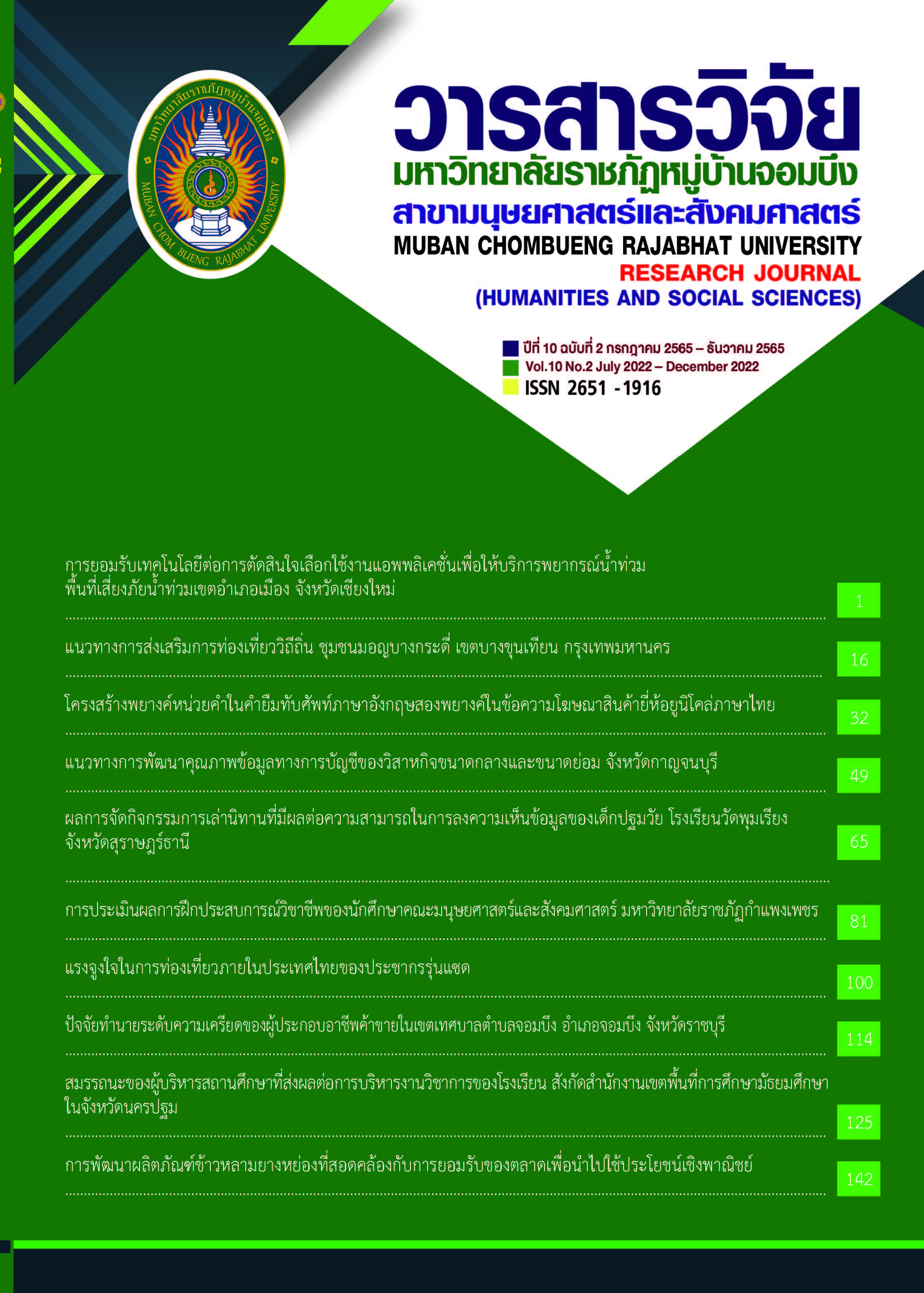การยอมรับเทคโนโลยีต่อการตัดสินใจเลือกใช้งานแอพพลิเคชั่นเพื่อให้บริการพยากรณ์น้ำท่วมพื้นที่เสี่ยงภัยน้ำท่วมเขตอำเภอเมือง จังหวัดเชียงใหม่
คำสำคัญ:
การยอมรับเทคโนโลยี, การตัดสินใจเลือกใช้งานแอพพลิเคชั่น, แอพพลิเคชั่นพยากรณ์น้ำท่วมบทคัดย่อ
การวิจัยนี้มีวัตถุประสงค์เพื่อศึกษาอิทธิพลของการยอมรับเทคโนโลยีที่มีต่อทัศนคติที่มีต่อการเลือกใช้งานเทคโนโลยี และการตัดสินใจในการเลือกใช้งานแอพพลิเคชั่น การเก็บรวบรวมข้อมูลจากกลุ่มที่มีโทรศัพท์เคลื่อนที่อาศัยอยู่ในพื้นที่เขตอำเภอเมืองเชียงใหม่ใน 16 ตำบล จำนวน 400 คน สถิติที่ใช้ในการวิเคราะห์ข้อมูล ได้แก่ ค่าร้อยละ ค่าเฉลี่ย ส่วนเบี่ยงเบนมาตรฐาน และสถิติที่ใช้ทดสอบสมมติฐานคือ การวิเคราะห์การถดถอยมาตรฐาน และความสอดคล้องระหว่างโมเดลเชิงสมมุติฐานกับข้อมูลเชิงประจักษ์ ผลการวิจัยพบว่า กลุ่มตัวอย่างส่วนใหญ่มีจำนวนโทรศัพท์ในครัวเรือน 3-4 เครื่องต่อครัวเรือน การรับทราบข่าวสารแจ้งเตือนน้ำท่วมในพื้นที่ ได้รับแจ้งก่อนล่วงหน้า 1 – 6 ชั่วโมง รับทราบข้อมูลจาก เสียงตามสาย ได้รับแจ้งการเตรียมการรับมือและการให้ความช่วยเหลือ สำหรับภาพรวมความคิดเห็นของผู้ตอบแบบสอบถามอยู่ในระดับมากโดยพบว่า การยอมรับมากที่สุด คือ การคาดหวังความมีประสิทธิภาพ สภาพแวดล้อมที่สนับสนุน ความคาดหวังในการใช้งาน และอิทธิพลของสังคม ตามลำดับ และผลการทดสอบสมมติฐานพบว่า การคาดหวังความมีประสิทธิภาพ ความคาดหวังในการใช้งาน อิทธิพลของสังคม มีอิทธิพลต่อทัศนคติที่เกี่ยวข้องกับการเลือกใช้งานเทคโนโลยี และสภาพแวดล้อมที่สนับสนุน กับ ทัศนคติที่เกี่ยวข้องกับการเลือกใช้งานเทคโนโลยีมีอิทธิพลต่อการตัดสินใจเลือกใช้งานแอพพลิเคชั่น และผลการทดสอบโมเดลเชิงสาเหตุการยอมรับเทคโนโลยีที่มีอิทธิพลต่อการตัดสินใจเลือกใช้งานแอพพลิเคชั่นพบว่า มีความสอดคล้องข้อมูลเชิงประจักษ์อยู่ในเกณฑ์ดีมาก
เอกสารอ้างอิง
ChiangMai Municipality. (2018). khūmư̄ patibatkān pō̜ngkan kǣkhai panhā nam thūam pračham pī sǭngphanhārǭihoksipʻet [Handbook of Prevention and Solving Flood Problems for the year 2018]. ChiangMai Municipality, Meaung ,Chiang Mai. [in Thai].
Davis, F. D. (1989). Perceived usefulness, perceived ease of use, and user acceptance of information technology. MIS quarterly, 319-340.
Department Of Provincial Administration. (2018). rāingān sathiti čhamnūan prachākǭn læ bān pračham pī Phō̜.Sō̜. sǭngphanhārǭihoksipʻet [Report of population and house statistics for the year 2018]. Retrieved June, 1, 2019, from http://stat.dopa.go.th/stat/statnew/statTDD/views/
showDistrictData.php?statType=1&year=61&rcode=50. [in Thai].
Diamantopoulos, A. & Siguaw, J. A., (2000). Introduction to LISREL: A guide for the uninitiated. London: SAGE Publications, Inc,.
Hooper, D., Coughlan, J., & Mullen, M. R. (2008). Structural Equation Modelling : Guidelines for Determining Model Fit. The Electronic Journal of Business Research Methods, 6(1), 53–60.
Hu, L., & Bentler, P. M. (1999). Cutoff criteria for fit indexes in covariance structure analysis: Conventional criteria versus new alternatives. Structural Equation Modeling: A Multidisciplinary Journal, 6(1), 1–55. doi:10.1080/10705519909540118.
Jansorn, T., Kiattisin, S., & Leelasantitham, A. (2013, September). Study of acceptance factors for electronic payment services. In International Conference on Business and Information.
Janson, A., & Thiel de Gafenco, M. (2015). Engaging the Appropriation of Technology-mediated Learning Services–A Theory-driven Design Approach. Association for Information Systems.
Jantakoon, T. & Nilsook, P. (2018). kānyǭmrap kānchai mō bāi soēwitthēknōlōyī nai ʻudomsưksā [Acceptance Usage of a Mobile Service in Higher Education]. Journal of Humanities and Social Sciences Thonburi University, 12(28), 358-366. [in Thai].
Khunthong, U., Ananchairachata, N., & Racharak, B. (2020) . patčhai thī mī phon tǭ kānyǭmrap theknōlōyī thāng kānngœ̄n kō̜ranī sưksā rabop kān ra ngœ̄n phān samātfōn dūai theknōlōyī Near Field Communication ( NFC ) nai kān sư̄ sinkhā khō̜ng phūbǭriphōk nai Krung Thēp Mahā Nakhǭn . [Factors affecting the Acceptation of financial technology : Smartphone payment system with Near Field Communication technology to buy consumer products in Bangkok]. Rajapark Journal, 14(32), 23-36. [in Thai].
Lamb, C. W., Hair, J. F., & McDaniel, C. D. (1992). Principles of marketing. Thomson South-Western.
Prasertsri, P., & Wachirawongsakorn, P. (2015) . kānmī sūanrūam khō̜ng prachāchon nai kānkǣkhai panhā ʻuthokkaphai nai phư̄nthī lumnam yom kō̜ranī sưksā tambon wang čhik ʻamphœ̄ phōprathapchāng čhangwat Phičhit [People participation in flood problem solvingin Yom river basin area: A case study of Wangjik sub-district, Phoprathapchang district, Phichit province]. Proceedings of 53rd Kasetsart University Annual Conference. [in Thai].
Rogers, E. M. (2010). Diffusion of innovations. Simon and Schuster.
Stevens, J. (1992). Applied multivariate statistics for the social science. 2 nd edition. Lawrence Erlbaum Associate, Inc.: New Jersey. 699 pp.
Taylor, S., & Todd, P. (1995). Assessing IT usage: The role of prior experience. MIS quarterly, 561-570.
Thompson, R. L., Higgins, C. A., & Howell, J. M. (1991). Personal computing: toward a conceptual model of utilization. MIS quarterly, 125-143.
Vallerand, R. J. (1997). Toward a hierarchical model of intrinsic and extrinsic motivation. In Advances in experimental social psychology (Vol. 29, pp. 271-360). Academic Press.
Venkatesh, V., Morris, M. G., Davis, G. B., & Davis, F. D. (2003). User Acceptance of Information Technology: Toward a Unified View. MIS quarterly, 425-478.
Yu, S. C., Ting, C. J., Lu, H. C., & Fu, F. L. (2012, June). Older-users' acceptance of smartcard payment systems: An investigation of an old-street venders. In 2012 8th International Conference on Information Science and Digital Content Technology (ICIDT2012) (Vol. 3, pp. 551-556). IEEE.
ดาวน์โหลด
เผยแพร่แล้ว
รูปแบบการอ้างอิง
ฉบับ
ประเภทบทความ
สัญญาอนุญาต
ลิขสิทธิ์ (c) 2022 วารสารวิจัยมหาวิทยาลัยราชภัฏหมู่บ้านจอมบึง สาขามนุษยศาสตร์และสังคมศาสตร์

อนุญาตภายใต้เงื่อนไข Creative Commons Attribution-NonCommercial-NoDerivatives 4.0 International License.
วารสาร TCI อยู่ภายใต้การอนุญาต Creative Commons Attribution-NonCommercial-NoDerivatives 4.0 International (CC BY-NC-ND 4.0) เว้นแต่จะรุบุไว้เป็นอย่างอื่นโปรดอ่านหน้านโยบายของเราสำหรับข้อมูลเพิ่มเติมเกี่ยวกับการเช้าถึงแบบเปิด ลิขสิทธิ์ และการอนุญาต



